
|
BRADFORD MCINTYRE
SHOWING UP FOR LIFE
Cristina Padrés | Making a Difference
Responses | October 12, 2015
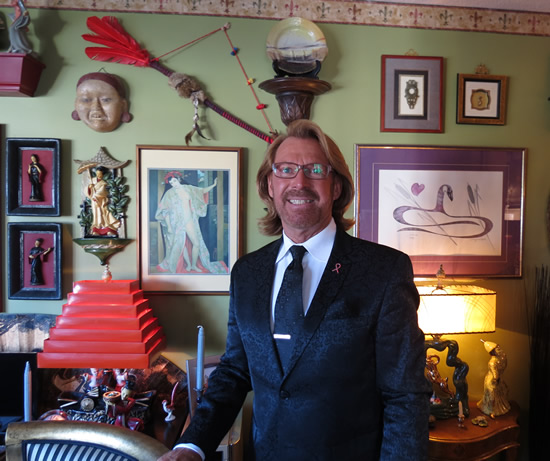 Photo: Bradford McIntyre, HIV+ 31 years - HIV+ since 1984
Photo: Bradford McIntyre, HIV+ 31 years - HIV+ since 1984.
For all intents and purposes, Bradford McIntyre’s story could be a movie. Thirty-one years ago, during the height of the AIDS (Acquired Immunodeficiency Syndrome) crisis, he was diagnosed with HIV (Human Immunodeficiency Virus). A year later, the doctors told him he had 6 months to live. This is a story of being given a death sentence, of enduring pain and self-imposed isolation but it is also a story of personal growth and making a difference. A difference that has been acknowledged with the Queen Elizabeth II Diamond Jubilee Medal in 2012, for excellence in the field of HIV/AIDS, in Canada, and the Pride Legacy Award in 2013, for Sexual Health & HIV/AIDS Awareness. Today, Bradford is an HIV/AIDS advocate, happily married to the love of his life and has given hope to thousands of people living with HIV around the world. The most intriguing part of his story is how Bradford decided to give purpose to his journey by speaking about his illness and sharing with others his experience.
Bradford is an inherently sweet person partly because he is genuinely positive and bubbly, and because he has so much compassion and kindness. He is graceful and elegant, a man who likes to take care of himself, not in a self-centred way, but in a wholesome form; a true gentleman. I asked him the seemingly innocent question of how did he get here. He let out a big sigh.
I had asked the biggest question of all.
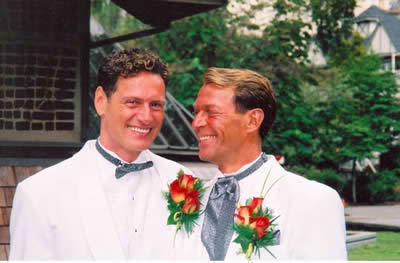 Photo: Deni Daviau (Left) and Bradford McIntyre (Right), on their wedding day,
Photo: Deni Daviau (Left) and Bradford McIntyre (Right), on their wedding day,
June 2nd, 2001.
So let’s start at the beginning.
In 1984, Bradford was diagnosed with HIV. There wasn’t much information about the illness and there certainly wasn’t a treatment. The news fell upon him like a death sentence. A year later, on November 28, 1985, he was given an official expiration date: he had 6 months to live and should put his affairs in order. Bradford didn’t want anyone to know he was HIV infected, so he moved away from family and friends. “I dealt with being HIV positive all by myself. I basically waited to die, but it didn’t happen and money ran out so I had to get a job. I started my hairstyling career all over again in Ottawa,” he recalls.
His job as hairstylist at Rinaldo’s–one of the top salons in Canada that cater to parliamentarians and ministers, among many other rich and famous–wasn’t exactly low profile and Bradford was living in constant fear not only of dying, but also of people finding out he was HIV positive. He isolated himself and decided against building any relationship. These years were full of pain and fear. “You can see how I decorate my home,” he motions around his apartment in the West End, where every inch has been carefully decorated and I get the feeling every object has a special story. “During that time, there wasn’t any point in decorating and making a home because I didn’t expect to be there very long. That apartment, with its blank walls, was my own little cage, my prison.”
In 1990, a client he had never met sat in his chair to get her hair done. Instead of looking at him through the mirror, the woman turned the chair around, looked directly into his face and told him he had suffered long and hard enough and that it was time to get on with his life. Bradford knew it was true.
He takes a deep breath and pauses letting his words sink between us. “I don’t talk about this very often, but when I do, I get a real sense of its great importance not just to me, but to the person that I am talking to.”
“That day when I got home, I walked across the street to the corner store and as I chitchatted with the girl behind the cashier like I had done for the past four years, it dawned on me that I did have relationships,” he adds. Bradford’s self-imposed isolation was over. He had served his suffering sentence. Soon enough, he met someone, who knew he was HIV positive. At this time, he was taking AZT—the first government approved treatment for HIV/AIDS— which doctors had been suggesting for some time.“ The first six months with the drug were fine, but then all hell broke loose. I started having all kinds of side effects such as insomnia, diarrhea, headaches, neuropathy to the point where I could barely walk and I was in excruciating pain. I looked like I was going to die,” Bradford remembers.
One afternoon, he came home to discover that his partner had left. “I was devastated. The next thing I knew I was sitting in a food court at a mall, crying my eyes out and thinking I don’t know what I need to do, but I need to do something because the next thing that comes along, I am not going to be able to handle it.” That same night, a friend threw him a lifeline, the book from Paul Ferrini The 12 Steps of Forgiveness, which he read through the night. The next day his partner called to see how he was and Bradford asked him to get together for coffee. “He was surprised I wasn t mad. I told him that he had to do what he needed to do to take care of himself. I wouldn’t have done that if I hadn’t read that book the night before. I asked myself what would I have done? Could I have handled it? I don't know the answer to that and I had to forgive him for what he did.”
This episode marked the beginning of Bradford’s emotional, mental and physical healing. “I thought I was trying to heal emotionally, but I also healed physically because even though I wasn t sick—except for taking the drugs— it was as if I was sick because of the constant state of stress, fear and anxiety I was in. I became able to recognize what was going on, if it was me causing it or if it was something else that was wrong and needed to see a doctor.” He also decided to stop AZT and started to feel better. Unfortunately, the side effect that caused the deterioration of the nerves in his legs is permanent damage and became an issue with work. “The problem with my legs made it hard to stand behind the chair all day. I wasn’t living under the fear of dying every day, but I was getting concerned of my secret coming out. There were some clients that wouldn’t use the washrooms because there were gay hairstylists in the salon. You have to remember this was the early 1990s. Yet, enough had taken place that HIV patient rights were being defended.”
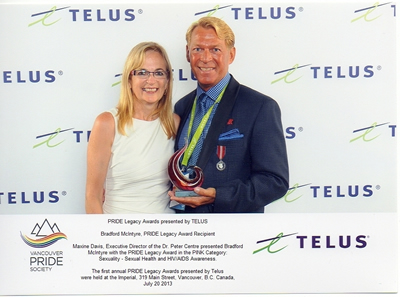
Photo: PRIDE Legacy Awards Presented by TELUS, Maxine Davis, Executive Director of the Doctor Peter Centre, presented Bradford McIntyre with the Pride Legacy Award in the PINK Category: Sexuality (Sexual Health + HIV/AIDS Awareness).
Finally, Bradford got the courage to seek help at AIDS Committee of Ottawa and with the help of his counsellor, he informed his employer he was HIV positive. “I couldn’t be fired because the organization would make them understand they couldn’t fire me. When Marilyn Neudorf, my counsellor and I explained it to Rinaldo, he accepted but asked to keep it secret, which was fine with me. I didn’t want people to find out but I needed to have support for those days when I wasn’t feeling well enough to go to work. I continued working but after some time I ended up leaving work because my legs just got bad.” Bradford decided to go home and stay with his brother for some time.
In early 1994, he got a severe case of shingles and was in bed for four months. As his health improved, a friend who had just taken a job in Vancouver asked him to drive her car there from Ontario. “I came here and found all the practices that I have been doing such as meditation, visualisation, and other different venues for healing. I was doing workshops every day, sometimes two a day,” he smiles from the memory of those early Vancouver days. He was still a visitor and the time to fly east was drawing near. The day before leaving, he was on the Burrard Bridge looking at the beaches, the mountains and the tankers. The stars had begun to appear in the evening sky, when he got an epiphany, “It just came to me. Of all the people that were making a difference with their life, the only difference between them and everybody else is that they were making a difference,” he explains. He decided right there and then that he was going to contact the media and tell them that he had been HIV positive for nearly a decade. He was going to tell his story about living with HIV; he would share with others the alternative and complementary therapies that have helped him in his emotional, mental, spiritual and physical healing.
When Bradford went back home to Ontario, he contacted the media and it turned out it was AIDS week, so he was featured in the Ottawa Citizen newspaper and on CTV national news. His next step was to write a letter about the needs of people who were HIV positive and sent it to the media and government (from the Prime Minister to Housing and Social Services). He sent up to 70 letters, but a week before sending the bulk mail, he sent one of the letters to Dini Petty. Three days later, he got a call from the Dini Petty Show, asking him to be a guest on the World AIDS Day show, December 1st 1994.
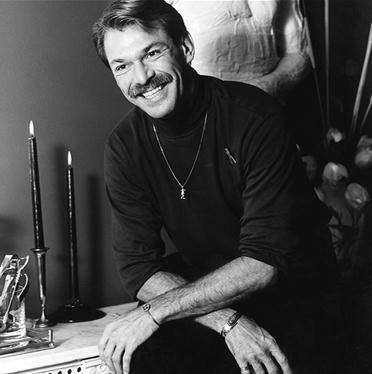
Photo: Bradford McIntyre featured in Michelle Valberg’s book LOOK BEYOND
The Faces & Stories of People with HIV/AIDS, a collection of black and white photographs and stories of people all across Canada living with HIV/AIDS. www.valbergimaging.com
Bradford’s appearance catapulted him to feeling even more the need to make a difference and contribute to the fight to end HIV/AIDS. Then Michelle Valberg, a photographer who was working on a book about individuals who were living with HIV in Canada, contacted him and asked to photograph him.“ Both Dini Petty and Michelle Valberg gave me the wings to soar. I didn’t plan anything; the only thing that I planned was contacting the media to tell my story. After that, all I really did was say yes when people asked me to speak at events. Each time I said yes and took part in an event or interview, it catapulted me to where I am today,” he says.
From 1994 to 2003, Bradford attended many engagements and volunteered with multiple causes and events; the interviews, film footage and newspaper clips piled up. His nephew, Trevor Uksik, built a website to organize and showcase all those years work. When Bradford McIntyre Positively Positive Living with HIV/AIDS (www.PositivelyPositive.ca) was launched in 2003, the website had 20 pages, and today it has over 5,000 pages and has reached 17 million from 176 countries.
In 2012, his work was acknowledged. Bradford received the Queen Elizabeth II Diamond Jubilee Medal. “I was able to show my family my medal and I was very proud. I had three uncles who were in the Second World War, so I grew up hearing their stories and looking at their medals.”
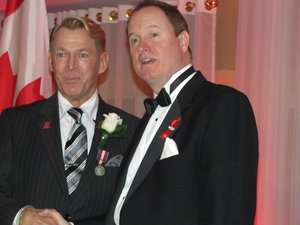
Photo: Bradford receives the Queen Elizabeth II Diamond Jubilee Medal on November 27, 2012. The Diamond Jubilee Medal was pinned by Dr. Colin Carrie, Parliamentary Secretary to the Minister of Health.
“Then, in 2013, I received the Pride Legacy Award in the Pink Category, which stands for sexual health. All these years, that I was doing HIV activism, my focus was not strictly on the LGBTQ community (Lesbian, Gay, Bisexual, Transgendered, and Queer (and/or questioning). However, living away from my immediate family, they are my extended family and for them to acknowledge what I have done for HIV/AIDS, I really felt that I had made it, made a difference!”
It sure hasn’t been an easy ride. Bradford has multiple health problems from osteoarthritis, to side effects of the drugs that have caused both neuropathy in his legs and chronic thyroid disease. He has been close to death three times and each time he has had to build his body back. “In 2004, I had my face reconstructed because of facial wasting which was a side effect of both HIV and some of the earlier drugs treating it. Now, the new challenge is being HIV positive and aging. I am 63 years old. Recent studies state that HIV accelerates the aging process approximately 14 years, so I have the body of someone who is 77,” he said laughingly.
So how did Bradford get here?
“From being all alone, waiting to die, my life became about a world of connect edness to all these people with whom I am in a relationship. For the last 21 years, I have been an advocate creating HIV/AIDS awareness and I have had the best time, done things that I could never have dreamt of doing in my wildest dreams, wanted to do or even thought I could do. I’ve spoken on Parliament Hill, I’ve spoken to 130,000 people in the Zócalo Square in Mexico City, I’ve done documentaries and I’ve been participating in all sorts of causes from small HIV-AIDS organizations to large corporations and organizations. The fact that I was able comes from me stepping outside of the box, stepping outside of my own insecurities and my own fears.
It is the why I'm doing it that has allowed me to do it .”
To learn more about Brandford’s story, visit his website
www.positivelypositive.ca
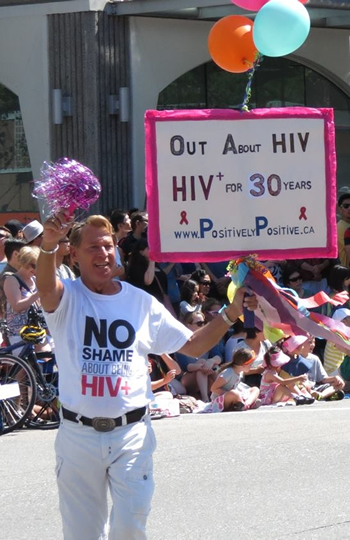
Photo: Bradford marching in the Vancouver PRIDE Parade 2014.
Source: http://www.vancouverites.ca/bradford-mcintyre-showing-up-for-life/
"Reproduced with permission - Vancouverites"
Vancouverites
www.vancouverites.ca
|